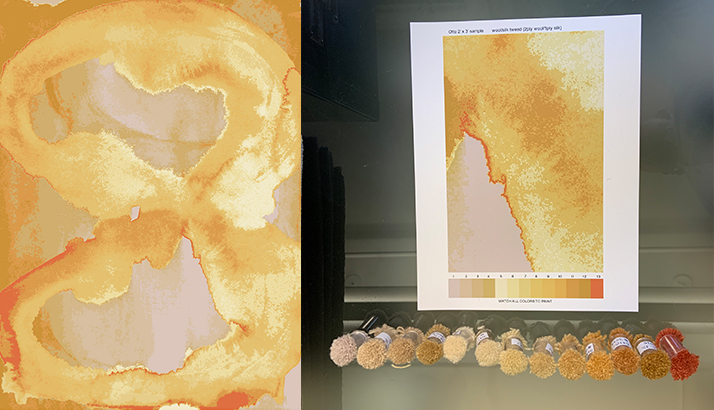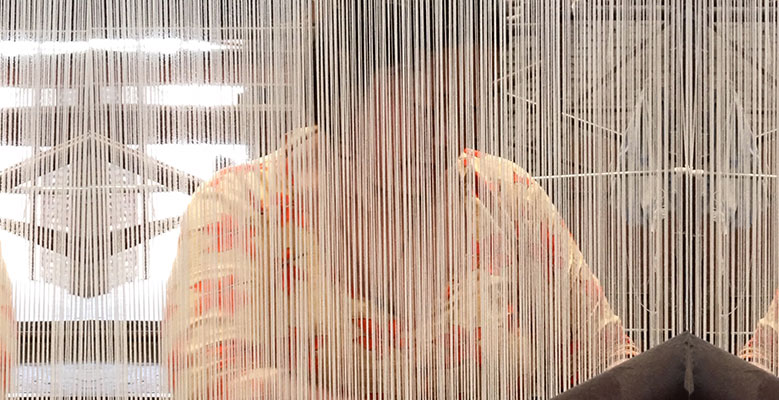Fort Street Studio principals, Janis Provisor and Brad Davis, spent the last two weeks of March 2019 traveling with me, Senior Vice President of Fort Street Studio, Paul Melo, and visiting our weaving mills in Nepal and India.
The trip was an opportunity to work on the ground with master weavers and dyers to create prototypes for new designs, colors and qualities. Not only is there an efficiency to working out ideas in real time over several days, there is also design inspiration all around in the exotic areas around Kathmandu Nepal and Rajasthan India. Prior to traveling, Janis and Brad spent the latter part of 2018 painting and creating new carpet designs, which are the precursors to the prototypes.

After our New York based design studio transforms water color art or other paintings into weaving graphs, color testing is performed by making lab dips that show the color of the yarn. The colors are dyed until the precise value steps are achieved. These color value steps are needed to ensure the color progressions necessary to match the look of the painting/art.



Once the dye recipes are perfected, the production process begins with the preparation of raw materials. We only use fibers of high integrity – such as the best, lanolin-rich, high-altitude Himalayan wool, which is hand combed, hand carded and hand dyed. We also incorporate high quality cultivated silk and nettle in several designs.

The carpets are hand knotted on upright looms with cotton warps in most cases and one weaver is assigned to every 3 feet of width. The carpets are not only hand knotted, but the foundations are woven by inserting a row of cotton across the weft after each row of knots is tied. This process takes more time, but it is a step that distinguishes Fort Street Studio carpets from cheaper hand knotted carpets often sold through mass retailers. The “fully crossed” construction of Fort Street Studio’s Tibetan knot carpets ensure higher durability and longevity.



After several months on the loom, where weavers complete about 12 inches per week for intricate designs, the carpets go into finishing where they are washed, blocked, dried in the sun, then sheared and hand surged. The carpets are washed with filtered water and mild detergent to soften the wool and exposure a gentle luster. Blocking locks the shape of the rug in place and the shearing yields a tidy cut pile.


Visiting the mills reminds us of the thousands of human hours, attention to detail and careful craftsmanship that go into every carpet – aspects of fine hand knotted carpets that are not always immediately visible nor appreciated. Even care for the environment is taken into consideration during production. In Nepal, our suppliers have smoke-free boilers, water filtration systems, and solar panels to decrease reliance on expensive and uneven electrical supply.

After working all day at the mills, it is important to enjoy the local culture and beauty which serve as inspiration. The Dwarika Heritage Hotel in Kathmandu is a perfect place to appreciate exquisite Nepali architectural traditions as well as a traditional Nepali meal.




Rajasthan, India is a most enchanting state and we happen to arrive on the eve of Holi, the spring festival of color and renewal which ushers out the end of winter. It also serves as major color inspiration in a country that is already no slouch in the vivid color department!



We spent the week working with our mills there, again on new designs and techniques, as well as reviewing prototypes we had ordered in the fall. Some, such as our new Picket design, were given final sign off and put into production for stock.

In the evenings, we were inspired by the beauty of the mogul architecture of the palaces, most of which have been converted into hotels with a nice selection of restaurants from fine to casual or open air dining.


In addition to the requisite shopping at Khadi shops for amazing Indian cotton goods, we were able to squeeze in a visit to the new Gyan museum in Jaipur designed by our friend and fellow New Yorker, French architect, Paul Mathieu. The museum is super chic and houses the private collection of the late Shri Gyan Chand Dhaddha, which includes amazing mogul paintings, smoking pipes, fine jewelry and textiles.



